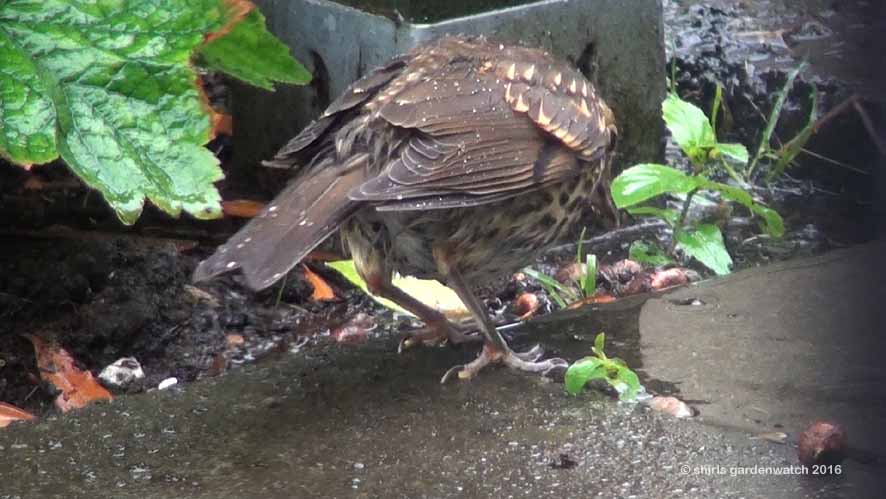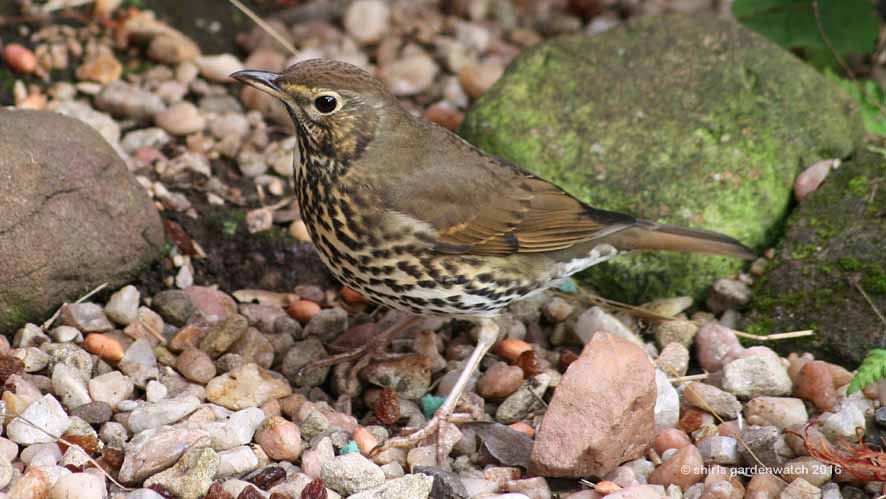The year was 2013, the month July and what a boom of newly fledged chicks were to be seen visiting the garden then – so my handwritten blog diary tells me. At this time, exciting family stuff was going on and postings were few but the recording of photos, video and gardenwatching notes in my well-loved, hardback, A5 yearly diary continued.
As mentioned in comments in my previous post, the song thrush is in serious decline in many parts of the UK. So, it’s no surprise then that a possible first sighting of juvenile song thrush in my garden was exciting! But was that what I was seeing? I wasn’t sure.
Gardenwatching over nine years has taught me many things (forever learning) especially when it comes to identifying new garden visitors. Rushed record photos aren’t always clear enough for an ID. Yes, granted, videos (often shaky) help more but its observing the behaviour of the new visitor that usually clinches it. Juveniles always catch my eye (or ear if they are newly fledged and begging for food). The youngster below caught my eye. The image above is a screen grab from the first video below.
New visitors to garden, watch the activity of other birds before joining in.
Juveniles watch longer, look lost and are seen standing and walking over soft plant foliage. It’s fascinating watching them and wondering what they are thinking. The first video below shows this juvenile song thrush visitor standing on the edge of a birdbath. It moves on when a blackbird comes down to drink (bottom RH corner).
Having never seen a song thrush juvenile with or without parent feeding it in the garden its only guess work at what it has been fed. Guess work again re it perhaps never having seen a parent smash a snail shell to break in to get to food inside. That said, could this inexperienced youngster know already to look for snail shells? It might look so in this next video.


of newly fledged youngsters have shown they taste anything they come across.

all bulbs to make sure there’s nothing tasty there. An adult bird would move swiftly on.

These adult song thrush images were taken back in October 2007 and have been included here for comparisons between an adult and a juvenile song thrush. Please note that there isn’t blue slug pellets in gravel, it was decorative pot dressing/grit that spilled over from a container.


At the time of this juvenile sighting, it was its shorter wings that caught my eye and the face looked slightly different too. On looking at these images further, I spotted that the adult has a pale defined eye ring. That helped a lot, should I see a juvenile again. It’s all these little details that have been fascinating to discover when gardenwatching. Being very much an observer of garden visitors, I enjoy this part.
For this blog post and descriptions on the appearance differences between the adult and juvenile song thrushes, I referred to my bookshelf and the few bird books I have collected over the last nine years. However it was a book bought, many years before and recently unearthed during an attic clearance that I have found a great resource recently.
A caption next to a small illustration of a juvenile Song Thrush in an old Reader’s Digest (Nature Lover’s Library) Field Guide to the Birds of Britain gave me the best clue by far. Next I searched through my photos and video screen grabs to illustrate this for my own records. Hopefully this will be of help to others wondering if they too have seen a juvenile song thrush.

This speckle can be very clearly seen above on the juvenile song thrush on the right.
Finally, there is another Song Thrush comparison that many people search for – I know I have. What’s the difference between the song thrush and the mistle thrush? Well, I was aware that the mistle thrush was larger and a bit greyer but that’s a bit vague so I went searching for a video and discovered a good one by the British Trust for Ornithology (BTO). I hope this of interest of others too.
Being fully aware that the song thrush is a shy bird as well as a rare one in some areas of the UK, Yorkshire for example where fellow blogger Sue is, I wanted to share my special sighting and images.
I would also like to share a theory by Dominic Couzens in ‘The Secret Life of Garden Birds’ that is currently on my bookshelf. He suggests that perhaps numbers are in decline due the young birds not finding food in the first two or three months after fledging. I do hope the youngster above did not fall into that category.
Wishing everyone reading this song thrush sightings in the future especially if you are not seeing them now. If you are seeing them, I hope you continue to do so. Hopefully there can be a turnaround in the decline of this species here in the UK. Fingers crossed.
This post was published by Shirley for shirls gardenwatch in January 2016.

We always had song and mistle thrush's in the garden when I was growing up. My grandfather called the mistle thrush the storm cock, they would sing from the highest tree when storms where due. I rarely see either of them now.
I enjoyed seeing your video and also the video of the thrush singing. Beautiful!
Hi Shirley, enjoy your blog a lot and had to respond to the song thrush post. I live in the suburbs of Glasgow where there are a lot of mature trees. Last summer I was delighted when a song thrush serenaded us through the summer after a good, few years absence. Why they returned last year, who knows? Not much has changed that I can see just hope they are here again this year. Really helpful identification pictures.
Sheena
Hello again to you all, thanks for popping by and leaving your comments 🙂 It’s a lot warmer here today, the snow is gone and the bird feeders quiet.
Brian, I love the storm clock name and story – I wonder if this is familiar to others too. I’ve never heard of it myself. My early wildlife memories are of watching frogs in a horseshoe shaped pond and the red squirrel running around the woods. Apart from moving into our first house with a garden (age 8) and discovering a nest built near an outside tap, I paid no attention to birds at all. I am sorry again to hear that the Song and Mistle thrush is absent from your area of the UK.
Lisa, what a treat it has been to share this with you. I’m so glad you were able to listen to our Thrush singing too. Taking a quick image search I can see that your Wood Thrush looks similar to our Song Thrush. I strongly suspect their song is a bit different with you being in the US when here in the UK it can be said that birds can have slight variances depending on where they are (at least I’m sure I’ve heard that somewhere).
Sheena, thank-you, I am delighted that you have left your comment here 🙂 It’s great to hear that you have been enjoying my blog but even better that you have a have a positive story about the Song Thrush. How fantastic to be able to hear it. I’ll have to listen more to the BTO video to know what I am listen for. I do hope you hear and see the Song Thrush this year too 🙂
Excellent observations Shirl. I have that same book and it is lovely. Once you see a mistle thrush and a song thrush together you know the difference and I used to see lots when I lived in North Yorkshire. Here at this new place my tiny garden is too small for them to visit but they are in the area and I see and hear them regularly.
We have some female blackbirds that are distinctly speckled that I think many mistake for dong thrushes. By the way great photos.
Hello again to you both 🙂 Hope you are having a great weekend.
Suzie, the illustrations and notes are great in this book aren’t they? I also discovered another RD book in the series during my attic clearance – Wild Flowers of Britain and I love that one too 🙂 Thanks, that helps me if ever I see these Thrushes together. I had thought the Mistle Thrush had visited my garden but after watching the BTO video I’m now not so sure. I hope my observations help even just one person. I recently read on a RSPB page that North and West Yorkshire were seeing a drop in Song Thrushes and Starlings where South Yorkshire was seeing a small increase – but that page was posted back in 2013. My garden is small too, hopefully they will visit yours. Brilliant though that you can see and hear them around your area 🙂
Sue, I know what you mean with the Blackbirds – I used to think these slightly speckled birds could be Redwings (wishful thinking on my part). Thanks, video grabs can give great captures especially if the light is bright 🙂